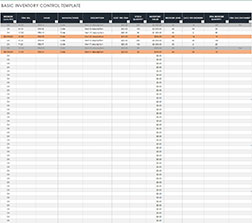Inventory Management Template
In a nutshell, inventory management refers to the systematic approach to storing, sourcing, and selling inventory. Considered an integral component of the supply chain, inventory management includes overseeing and controlling purchases and the number of products for sale, the maintenance of stock storage, and order fulfillment.
Knowing how much to order and when, can quickly become a complicated process without the right tool. Fortunately, tools like inventory management templates can save the day. The importance of inventory management cannot be overstated. For some, inventory management can make or break a business.
Inventory management is considered especially important for eCommerce and online retail brands. As you move from a small warehouse space into a larger facility, the need to efficiently manage inventory becomes increasingly crucial. With an inventory management template, it’s also easier to increase profitability and efficiency.
Importance of Inventory Management
For any goods-based business, the importance of inventory management cannot be overemphasized as it can significantly affect your operational efficiency and the longevity of your business. While seemingly complicated, inventory management in business is all about balance.
When there is overstock (you invest in more inventory than you can sell), you can create a deficit in your budget. If there’s not enough in your inventory, you can also compromise customer service. Often, the cost of excess inventory is deducted from the profits. The goods will just be disposed of and counted as losses.
Lack of inventory on hand to meet customer demands (also known as stockout) can also hurt your business. You can easily lose a sale if you don’t have enough inventory to fill a customer order. If you are always out of stock, your customers might move to other suppliers that can provide what they are looking for.
With your inventory management template, it is a lot easier for you to accurately forecast the inventory you will need based on sales activity. It also enables you to place orders accordingly to prevent overstocks and stockouts. Keep in mind that managing your supply chain accordingly is the backbone of your business.
Peerless Benefits of an Effective Inventory Management System
Effective inventory management is the cornerstone of any successful business. This is especially true among eCommerce and online retail brands. Below are some of the most notable benefits of having an effective inventory management system:
Better inventory ordering and planning
Understandably, it would be difficult to gauge which products are needed if you have no means of telling what products are currently in stock. Without proper inventory management, you can end up overstocking on items (some of which might not even be strong sellers). Using an inventory management template can help address similar issues and help you refresh inventory only when needed. This is considered both cost and space-effective.
Accurate order fulfillment
Imagine this prevalent scenario: a customer places an order and you receive the order. The request is forwarded to the warehouse only to discover that the item ordered is no longer in stock. This is a possible scenario with a poorly managed inventory. An inventory management template can help you create an excellent inventory system so you can avoid running out of stocks, high return volumes, and possible loss of customer base.
Increased customer satisfaction
Most customers that shop online often wait for their orders eagerly, and there’s nothing more frustrating than having orders arrive late, damaged, or not arrive at all. When this happens, buyers are less likely to purchase from you again. Fortunately, when you have a sound inventory system, you can quickly fulfill orders and ship them out faster. Providing a great customer experience can help your brand build a more loyal and robust following.
Inventory Management Best Practices
Manage your inventory more effectively by keeping the following inventory management best practices in mind:
Use the FIFO method (First In, First Out)
It is recommended that you sell goods in the same chronological order as they were created or purchased. This is especially ideal if you are selling perishable products like food, flowers, or makeup. This can also apply to nonperishable items, and they can get damaged or become out of date and unsellable when allowed to sit around for far too long.
Identify low-turn stocks
If you have stocks that have not been sold in the last six to twelve months, it would be wise to stop stocking said items. It would also be a good idea to employ different strategies to get rid of the stock, like running a special discount or other promotions.
Perform regular stock audits
Even if you are using an inventory management template, you still need to periodically audit your inventory to ensure what you have on record matches your actual stocks. Businesses employ various techniques, including spot checks and year-end physical inventories.
DOWNLOAD
